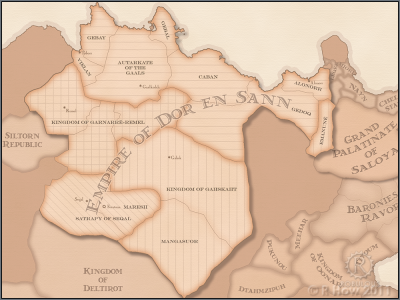Table of Contents
Kingdom of Seqal
The Kingdom of Seqal was an ancient Issid state centred on the city of Seqal. Due to the city's strategic location on the River Wiyel it became a wealthy nation based on trade in jade, cultural artefacts and metal ores.
Empire of Dor-en-Sannplugin-autotooltip__small plugin-autotooltip_bigDor-en-Sann (Category)
A list of articles related to the ancient Empire of Dor-en-Sann
topics fornat1
This is in a series of articles about the historic multi-ethnic state, the Empire of Dor-en-Sannplugin-autotooltip__small plugin-autotooltip_bigEmpire of Dor-en-Sann
The Empire of Dor-en-Sann, [DOORR-enn-SAHN] also called the EnSanni Empire, was the largest empire in history. It dominated central Anásthias for nearly two thousand years, from 1903 BME, until the conquest of Galkesh in 59 ME. The empire consisted of hundreds of ethnic groups and cultures, its people were collectively called the MEOrorrHMOrorrHMHartheraME, which existed from c.1900 BMEplugin-autotooltip__small plugin-autotooltip_bigBME (Before Modern Epoch)
Used to date years Before the Modern Epoch.-60 MEplugin-autotooltip__small plugin-autotooltip_bigME
ME is short for Modern Epoch, the modern method of numbering years..
It was also an important religious centre with it's famous Eidolons overlooking the river. In its later history it was defeated by the Empire of Dor-en-Sann, and incorporated into the empire.
History
There is evidence for occupation of the caves around Seqal from the 8th millenium BME onwards, with the first Issid chiefdoms recorded from c. 7400. The first kingly dynasty arose around 6000 BMEplugin-autotooltip__small plugin-autotooltip_bigBME (Before Modern Epoch)
Used to date years Before the Modern Epoch., but it wasn't until the excavation of the Eye, Seqal's secure hidden harbour, in c.5700 BME that the city began to be truly wealthy. This is called the age of the Dawn Kings, who carved elaborate tombs into the eastern cliff face. This tradition of rock tombs in the cliffs continued up to 3000 BME.
Governance
Though named a kingdom, the state's government fluctuated between elements of theocratic, monarchic and republican forces.
It was officially ruled by the Jade Queen and the Kings of the Eye. The queen was the chief priestess of the Temple of the Eidolons, usually a daughter of a noble family raised from a young age by the priestesses. The Sons were merchant princes forming a council. Each king represented either an important monopoly, strategic commodity or cartel of lesser merchants.
Despite its wealth it was reliant on importing food due to the arid luck terrain, so military it was also reliant on either paying off aggressors our hiring mercenaries. In the Beryl Epoch it was absorbed as a constituent kingdom of the Empire of Dor-en-Sann, but was later reduced to a satrapy after numerous rebellions against imperial taxation.
